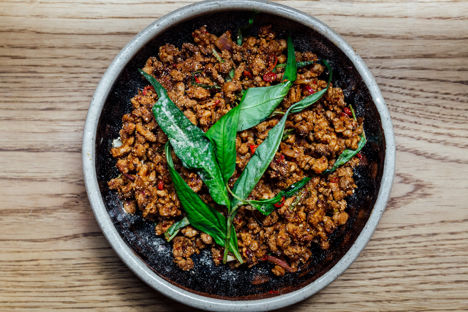
7 of our hottest recipes to test even hardcore chilli fans
Have a head for heat? Brave the burn with these intensely spicy recipes – they'll put even true chilli connoisseurs through their paces.
7 of our hottest recipes to test even hardcore chilli fans
Have a head for heat? Brave the burn with these intensely spicy recipes – they'll put even true chilli connoisseurs through their paces.
When we eat spicy food, the chemical compound capsaicin, which is responsbile for chilli peppers' heat, triggers heat receptors in our skin and tricks our brains into thinking we're overheating. In response, we release endorphins – or feel good hormones – and adrenaline, giving us a high. It's why we sometimes find ourselves craving hot food and why chilli fanatics often describe their love of it as addictive. In short, eating hot food is as much about sensation as it is taste. That's not to say it lacks flavour – far from it. The thousands of chilli peppers around the world are packed with fruity, floral, citrus, tangy and earthy notes, and the best chefs draw these – as well as their heat – out.
If you're always reaching for the hot sauce, have a browse through our collection of chilli recipes – there's strawberry and chilli jellies, prawn-stuffed chillis, fermented chilli flatbreads and much more – or narrow in on the likes of Scotch bonnet or Sichuan peppercorn recipes for a serious kick. Fancy dialling it up another notch? Below, we've picked out just some of our most ferocious dishes – they're from cuisines all over the world, but have one thing in common: they're not for the feint of heart.
Shutki shira – Bangladeshi dried shrimp stew
Dina Begum's Bangladeshi shutki shira combines dried shrimp, potato, aubergine, pumpkin and spinach in an aromatic broth. The heat comes from naga chilli, one of the hottest chilli peppers in the world – it measures anywhere between 800,000 and 1,000,0000 SHU on the Scoville scale (jalapeños, for context, are usually between 2,000 and 8,000). Naga is known for its unique sweet, slightly tart, flavour and is well worth seeking out, but Dina says you can substitute for Scotch bonnet if you can't track it down.
Pork larb
Thai cooking is famously fiery, and Kiln's ferocious pork larb is no exception. The recipe includes a home-made chilli powder – Kiln uses fourteen different spices in theirs, but at home it's fine to use a handful of your favourite dried chillies (roast them in a hot, dry pan – keeping your windows open – and grind to a fine powder) or a good quality chilli powder. They also use hot mint and lime for a hot, sour and aromatic finish.
Kua kling mu – Dry-fried pork and green peppercorns
John Chantarasak's recipe for kua kling mu, or dry-fried pork, uses a whopping nine dried bird's eye chillies (hovering between 50,000 and 100,000 SHU) in the curry paste – as well as a host of fragrant aromatics – and another tablespoon of whole bird's eye chillies when he fries the pork. The result is a hot and salty dish with turmeric, lemongrass and makrut lime leaf notes.
Burnt morita chilli and sesame seed salsa
For this fiery burnt morita chilli salsa, Nud Dudhia chars three different types of chilli – seven dried moritas, one fresh habanero and two fresh jalapeños – on a barbecue until blackened, before blitzing them with tomato, onion and garlic into a smoky, spicy salsa, which is fantastic spooned over meat in tacos.
Gaeng som pla – Sour orange curry of sea bass and bamboo
Another bracingly spicy recipe from John Chantarasak, this time the southern Thai gaeng som pla (a sour orange curry of sea bass and bamboo), in which he uses nine dried bird's eye chillies and six fresh ones in the sour orange curry paste. Sour orange curries are hugely versatile, with Thai families usually having their own recipe – use any combination of fish, seafood and vegetables, depending on what you have to hand.
Awaze chicken thighs
In this Ethiopian-inspired recipe, we've marinated chicken thighs in a fiery awaze spice paste, which is made from berbere (a spice mix made with dried bird's eye chillies and a dizzying array of spices including cumin, cinnamon, fenugreek, ginger and nutmeg), garlic and tej, a type of Ethiopian mead. You can substitute it for dry sherry if you can't get your hands on it.
Ikan assam pedas (hot and sour fish stew)
The key to Abby Lee's Malaysian ikan assam pedas (which translates as sour and spicy fish) is a well-cooked rempah, or paste. She uses a heady mix of chopped red chillies and eight dried kashmiri chillies, as well as lemongrass shrimp paste, turmeric and red onion. Abby turns it into a stew, in which the mackerel is poached.
Fancy making a spice-packed condiment of your own? Don't miss our how-to make chilli crisp guide here.


